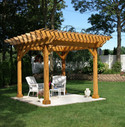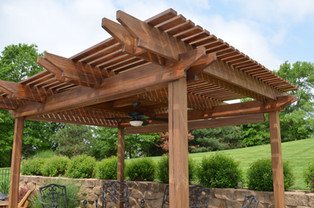- Feb 23, 2021
- 2 min read
Updated: Feb 28, 2021
Homeowners eagerly await the arrival of the warm weather so they can cast off the remnants of cabin fever and bask in the sunshine. However, as summer nears its dog days, the same sun homeowners once coveted can contribute to uncomfortable conditions in outdoor entertaining spaces.

Meteorologists at took to their neighborhoods in July 2020 to test just how hot surfaces can get in the sun during peak daytime temperatures. Concrete sitting in the sun almost all day reached a temperature of 134.7 F, while the same concrete in the shade clocked in at just under 80 F. When air temperatures are around 90 F, unshaded concrete and asphalt can be 125 F and 140 F, respectively. While wood decking may not be as hot as asphalt and concrete, it still can get steamy underfoot.
Homeowners who want to be able to enjoy their outdoor spaces in an array of temperatures can think about investing in shade solutions. Sun-blocking ideas like awnings, shade trees and large umbrellas can help people enjoy their yards all day long.
Canopy: A patio canopy is typically a freestanding unit that can be installed over a patio or a deck. Some people prefer to bolt it down so it will not be knocked over in windy conditions. The fabric on the canopy can be removed during the offseason, helping to improve its longevity.
Awning: Awnings may be stationary or retractable. Many are installed directly onto a home and can cast shade on specific areas of outdoor entertaining spaces.
Shade sail: Similar to an awning but a bit less structurally rigid, shade sails are large pieces of triangular fabric installed over areas of a patio, pool or landscape, according to The Family Handyman. Shade sails are light and airy and can be customized.
Trees: A natural way to increase shade in a yard is to plant more shade trees. If sun glare is an issue all year long, and itÕs not just the heat of the sun that is troublesome, think about planting evergreen trees. Deciduous cousins will drop their leaves in fall and only be effective during the warm weather.
Patio umbrellas: Many umbrellas start at around $25. Umbrellas can be paired with patio tables, while stationary cantilever umbrellas sit out of the way on their own heavy-duty stands. A cantilever umbrella tends to provide more shade than patio table umbrellas.
Homeowners can block sunlight outdoors the way they do inside, offers MSN. Hang curtains from the sides of canopies or between posts on a deck to provide shade and cozy spaces.
Shade is in high demand when the sun is hot. Options abound for making outdoor areas more comfortable.












